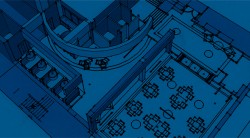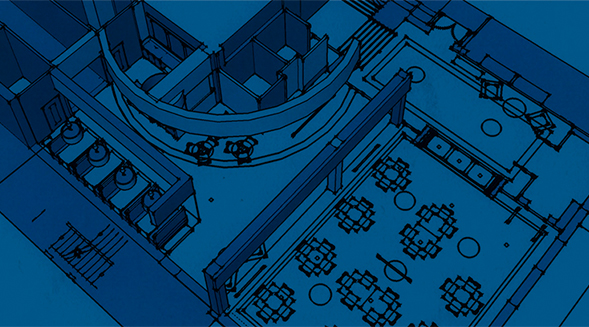 Renovations promote social learning
Renovations promote social learning
In the future, study spaces will look more like living rooms than voting booths. Students will cluster together in sunlit areas, seated on plush furniture as they debate theories, collaborate on presentations via virtually networked iPads, or just connect.
At Drake, that future has arrived. Construction is underway on spaces with open floor plans, moveable walls, and cozy collaboration stations. It’s all in the name of social learning, and according to Eunice Merideth, associate dean of the School of Education at Drake, it’s a “new” idea with more than a century of research behind it.
“Studies have looked at how people in workplaces have become more productive with open spaces in which to collaborate,” says Eunice Merideth, associate dean of the Drake School of Education. “This also is seen in studies of how students learn.”
Research on social learning—the theory that learning is more effective when students have opportunities to interact and learn from each other— has shown that students are capable of performing at a higher intellectual level when they are asked to collaborate.
“We get better when we all get better,” says Merideth. “Anytime you have active learning, you have active thinking. We don’t want students sitting in the back row being lectured. We need to tie into their natural curiosity. Children are social beings, and we don’t grow out of that.”
Space for scientific thought
This summer the University broke ground on a project to join two science buildings and build an inspiring space for thought, creation, and socialization between students and faculty. The two-story Morgan E. Cline Atrium for Pharmacy and Science will connect Cline Hall of Pharmacy and Health Sciences with Harvey Ingham Hall while providing ample study space, faculty offices, and an experiential learning suite.
The Hy-Vee Student Learning Commons, which will be located on the first floor of the atrium, will be outfitted with multiple collaboration stations and enhanced technology to promote creativity, team-building, problem-solving, and individual and team preparation.
“The commons will provide students with the ability to extend their learning outside the classroom and to develop the critical skills of working in teams, problem solving, and critical thinking that are so important as they transition into the work environments of today,” says Raylene Rospond, dean of the College of Pharmacy and Health Sciences.
The new space is made possible through a number of gifts to distinctlyDrake, including key support from Morgan E. Cline, Hy-Vee, and the Roy J. Carver Charitable trust, and is scheduled to open in early 2013.
After Hours in Cowles
Social learning strategies will also infuse the new Lower Commons area of Cowles Library, scheduled for completion this month. An area that includes the Cowles Café is being renovated to offer study space that will also serve as a safe, controlled access venue for after-hours study. The Cowles Lower Commons space will boast an open floor plan, movable walls, portable whiteboards, collaboration stations, and network access to support group interaction.
“Students spoke loud and clear to us,” says Rod Henshaw, dean of Cowles Library and professor of librarianship. “Two needs immediately rose to the top: a group study space and a late-night study facility.”
The library renovation includes the types of special touches that make social learning spaces successful such as flexible, comfortable seating, ample work surfaces, amenities like food and drink, and pleasing lighting and décor. It also offers easy access to research assistance and the Cowles computer lab. The Lower Commons/After Hours renovation is funded by the Cowles and Kruidenier foundations, Drake Board of Trustees member Mark Ernst, and University allocations.
The project is the first component in a series of renovations for the library. The next phase will include more formal learning spaces—a classroom, and space for group studies—as well as new technologies, academic support services and tools to support faculty and student media projects.
No lecture halls
A third project on the horizon is the proposed School of Education Building. The school’s design embraces social learning theory, and will be equipped to ensure that Drake education students are learning the most advanced strategies in classrooms designed for 21st century learning.
Plans include casual spaces for students to meet and work together, state-of-the-art technology, and a children’s art and music studio for hands-on learning. No lecture-only halls will exist in the new SOE building; instead, classrooms will be reconfigurable based on need, specially designed for collaborative learning.
In addition to collaborative space, plans include study carrels for students who need to concentrate as well as small conference rooms within the curriculum library for students to meet in groups.
“We want to ensure that students have the ability to be successful in any number of spaces,” says Merideth.
Building 21st century skills
Colleges and universities continue to revamp curriculum in an effort to bring students the skills that employers find most critical in the 21st century workplace: information literacy, collaboration, communication, creativity and innovation, problem solving, and responsible citizenship. By bringing these skills into the fabric of the day-to-day learning experience, Merideth says, Drake is taking a giant leap toward preparing students to excel in the modern workplace.
“Today’s employers need people who have the skills of collaboration, communication, and creativity,” says Merideth. “All of those things happen best in groups—in open spaces.”
— Jill Brimeyer


